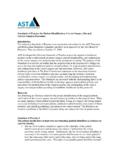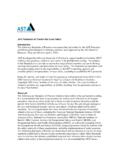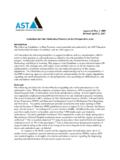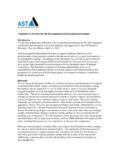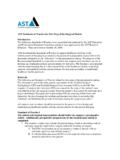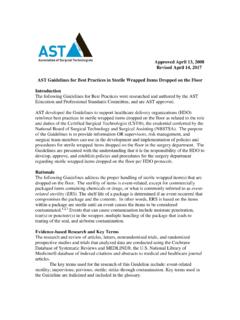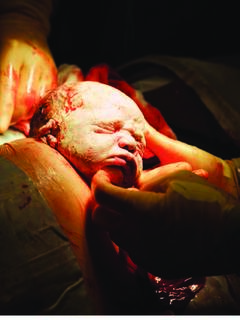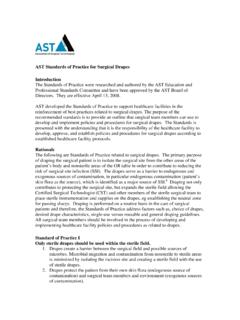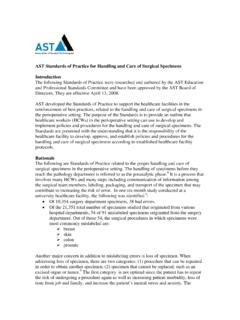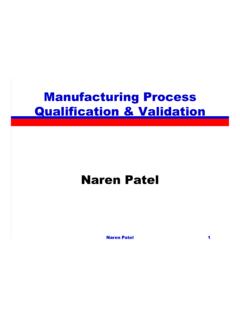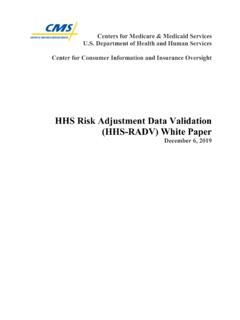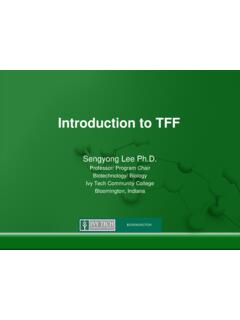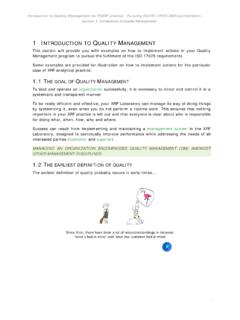Transcription of Standard Packaging Materials Preparing Items
1 AST Standards of Practice for Packaging Material and Preparing Items for Sterilization Introduction The following Standards of Practice were researched and authored by the AST Education and Professional Standards Committee and have been approved by the AST Board of Directors. They are effective October 19, 2009. AST developed the following Standards of Practice to support healthcare facilities in the reinforcement of best practices related to the selection and use of Packaging material for the sterilization of Items , including evaluation of the characteristics that are important to the selection of the Packaging material.
2 Additionally, general recommendations are provided regarding the preparation of Items for sterilization. The purpose of the Standards is to provide an outline that Certified Surgical Technologists (CSTs) and Certified Surgical First Assistants (CSFAs) can use to development and implement policies and procedures for Packaging material and Preparing Items for sterilization. The Standards are presented with the understanding that it is the responsibility of the healthcare facility to develop, approve, and establish policies and procedures for evaluating Packaging material according to established healthy care facility protocols.
3 Rationale The following are Standards of Practice related to the evaluation, selection and use of Packaging material in the perioperative setting, including general recommendations for the preparation of Items for sterilization. The four overall purposes of any type of Packaging system is to ensure the Packaging material allows the penetration of the sterilant, maintains the sterility of the contents until opened for use, and allows ease of use in order to open in an aseptic manner, and are cost effective.
4 There are a variety of Packaging systems, including woven fabrics, nonwoven Materials , plastic-plastic pouches, paper-plastic pouches (commonly called peel packs), and rigid instrument containers. Standard of Practice I Packaging Materials should be evaluated prior to adoption and purchase. This includes receiving samples of the Packaging material as test products to ensure it will meet the performance standards of the healthcare facility. 1. Packaging Materials and seals should have the following general characteristics: A.
5 Allow the sterilizing agent to penetrate and reach all surface areas of the item(s) to be sterilized. B. Maintain the sterility of the item up until its use; perform as a reliable barrier to microorganisms. C. Permit the package to be opened in an aseptic manner that allows for sterile Items to be easily removed or transferred to the sterile field without contamination. D. Conform to the size and shape of the item(s). E. Cover the contents in their entirety. F. Provide for maximum amount of use. G. Allow air to be completely removed during the sterilization process.
6 H. Withstand the physical conditions produced by the autoclave, including moisture, pressure and high temperatures. I. Be permeable to the sterilizing agent and moisture. J. Allow the escape and removal of the sterilizing agent at the end of the sterilization process. K. Allow the contents to be dried after sterilization with no presence of moisture. The Packaging material must also have the characteristic of being able to be dried to avoid wet packages upon removal from the sterilizer. This is particularly important when using ethylene oxide sterilization, since water combined with EtO can produce toxic byproducts.
7 L. Allow ethylene oxide gas and moisture to escape during the aeration cycle, when using ethylene oxide sterilization. M. Resist tears and punctures, during sterilization and normal handling. N. Should not easily degrade when the sterile packages are stored. O. Provide a barrier to the penetration of dust and particles, and resist moisture penetration. P. Woven fabrics should be lint free and also free of loose fibers. Q. Must not contain any toxic material or dyes that could produce a chemical reaction during the sterilization process.
8 The toxic residue could be harmful to the patient and the members of the surgical team, who are handling the Packaging material, and sterile team members, who are handling the contents. R. Reusable Packaging Materials should be free of bleaches and detergents that could produce a chemical reaction during the sterilization process. The toxic residue could be harmful to the patient and the members of the surgical team, who are handling the Packaging material ,and sterile team members, who are handling the contents, as well as cause instrument discoloration.
9 S. Promote integrity of the seal that is used to secure Items , so that content sterility is maintained. The seal should not spontaneously open, when the package is in sterile storage. T. Incapable of being re-sealed, once the seal is broken or package is opened. 2. Specific characteristics related to rigid container systems are: A. Easily open and provide for excellent sterile presentation of contents. B. Contain a removable lid that is sealable with some type of locking device. C. Broken locking device should be readily apparent.
10 D. Manufactured of a sturdy anodized aluminum, stainless steel, plastic or plastic-metal combination. E. Allow removal of all moisture and prevent collection of water in bottom of container. F. Be permeable to the sterilizing agent and moisture G. Allow complete removal of the sterilizing agent and drying of the contents and container itself. H. Allow for easy, aseptic removal of the sterile contents for use on the sterile field. 3. Specific characteristic related to paper-plastic peel packs are: A. Thickness of the plastic layer must be a minimum of 2 mm.
